NRSG353 Case Study: Analyzing Congestive Cardiac Failure
VerifiedAdded on 2023/04/08
|9
|2152
|70
Case Study
AI Summary
This case study provides a comprehensive analysis of congestive cardiac failure, including its definition, causes, incidence, and risk factors, along with its impact on patients and their families. It discusses common signs and symptoms such as shortness of breath, peripheral edema, and cyanosis, explaining the underlying pathophysiology of each. The study also delves into the pharmacodynamics and pharmacokinetics of frusemide, a loop diuretic commonly used in treatment. Furthermore, it outlines a nursing care plan for a patient with congestive cardiac failure, focusing on monitoring, sodium restriction, and respiratory support. The case study uses references to support its findings and recommendations for patient care.
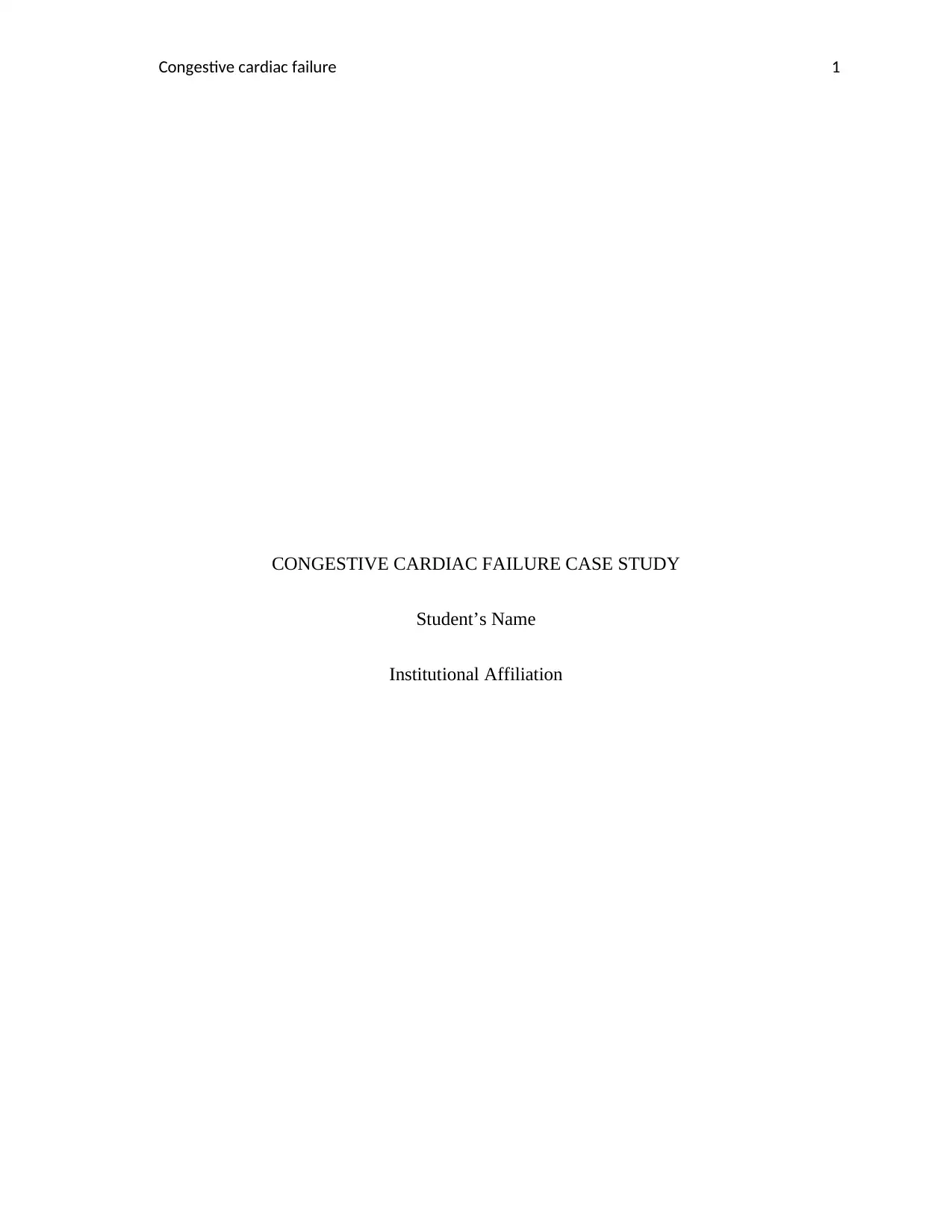
Congestive cardiac failure 1
CONGESTIVE CARDIAC FAILURE CASE STUDY
Student’s Name
Institutional Affiliation
CONGESTIVE CARDIAC FAILURE CASE STUDY
Student’s Name
Institutional Affiliation
Paraphrase This Document
Need a fresh take? Get an instant paraphrase of this document with our AI Paraphraser
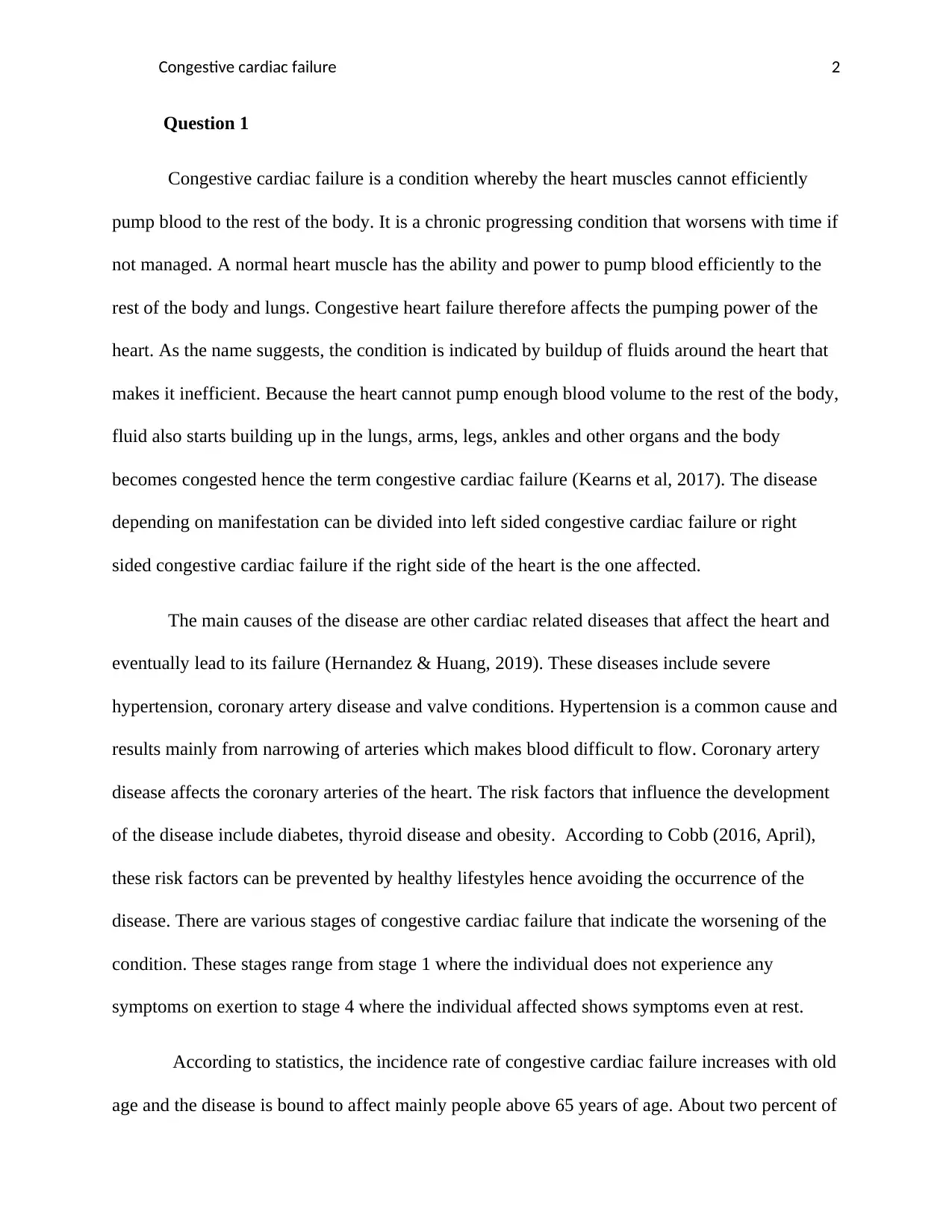
Congestive cardiac failure 2
Question 1
Congestive cardiac failure is a condition whereby the heart muscles cannot efficiently
pump blood to the rest of the body. It is a chronic progressing condition that worsens with time if
not managed. A normal heart muscle has the ability and power to pump blood efficiently to the
rest of the body and lungs. Congestive heart failure therefore affects the pumping power of the
heart. As the name suggests, the condition is indicated by buildup of fluids around the heart that
makes it inefficient. Because the heart cannot pump enough blood volume to the rest of the body,
fluid also starts building up in the lungs, arms, legs, ankles and other organs and the body
becomes congested hence the term congestive cardiac failure (Kearns et al, 2017). The disease
depending on manifestation can be divided into left sided congestive cardiac failure or right
sided congestive cardiac failure if the right side of the heart is the one affected.
The main causes of the disease are other cardiac related diseases that affect the heart and
eventually lead to its failure (Hernandez & Huang, 2019). These diseases include severe
hypertension, coronary artery disease and valve conditions. Hypertension is a common cause and
results mainly from narrowing of arteries which makes blood difficult to flow. Coronary artery
disease affects the coronary arteries of the heart. The risk factors that influence the development
of the disease include diabetes, thyroid disease and obesity. According to Cobb (2016, April),
these risk factors can be prevented by healthy lifestyles hence avoiding the occurrence of the
disease. There are various stages of congestive cardiac failure that indicate the worsening of the
condition. These stages range from stage 1 where the individual does not experience any
symptoms on exertion to stage 4 where the individual affected shows symptoms even at rest.
According to statistics, the incidence rate of congestive cardiac failure increases with old
age and the disease is bound to affect mainly people above 65 years of age. About two percent of
Question 1
Congestive cardiac failure is a condition whereby the heart muscles cannot efficiently
pump blood to the rest of the body. It is a chronic progressing condition that worsens with time if
not managed. A normal heart muscle has the ability and power to pump blood efficiently to the
rest of the body and lungs. Congestive heart failure therefore affects the pumping power of the
heart. As the name suggests, the condition is indicated by buildup of fluids around the heart that
makes it inefficient. Because the heart cannot pump enough blood volume to the rest of the body,
fluid also starts building up in the lungs, arms, legs, ankles and other organs and the body
becomes congested hence the term congestive cardiac failure (Kearns et al, 2017). The disease
depending on manifestation can be divided into left sided congestive cardiac failure or right
sided congestive cardiac failure if the right side of the heart is the one affected.
The main causes of the disease are other cardiac related diseases that affect the heart and
eventually lead to its failure (Hernandez & Huang, 2019). These diseases include severe
hypertension, coronary artery disease and valve conditions. Hypertension is a common cause and
results mainly from narrowing of arteries which makes blood difficult to flow. Coronary artery
disease affects the coronary arteries of the heart. The risk factors that influence the development
of the disease include diabetes, thyroid disease and obesity. According to Cobb (2016, April),
these risk factors can be prevented by healthy lifestyles hence avoiding the occurrence of the
disease. There are various stages of congestive cardiac failure that indicate the worsening of the
condition. These stages range from stage 1 where the individual does not experience any
symptoms on exertion to stage 4 where the individual affected shows symptoms even at rest.
According to statistics, the incidence rate of congestive cardiac failure increases with old
age and the disease is bound to affect mainly people above 65 years of age. About two percent of
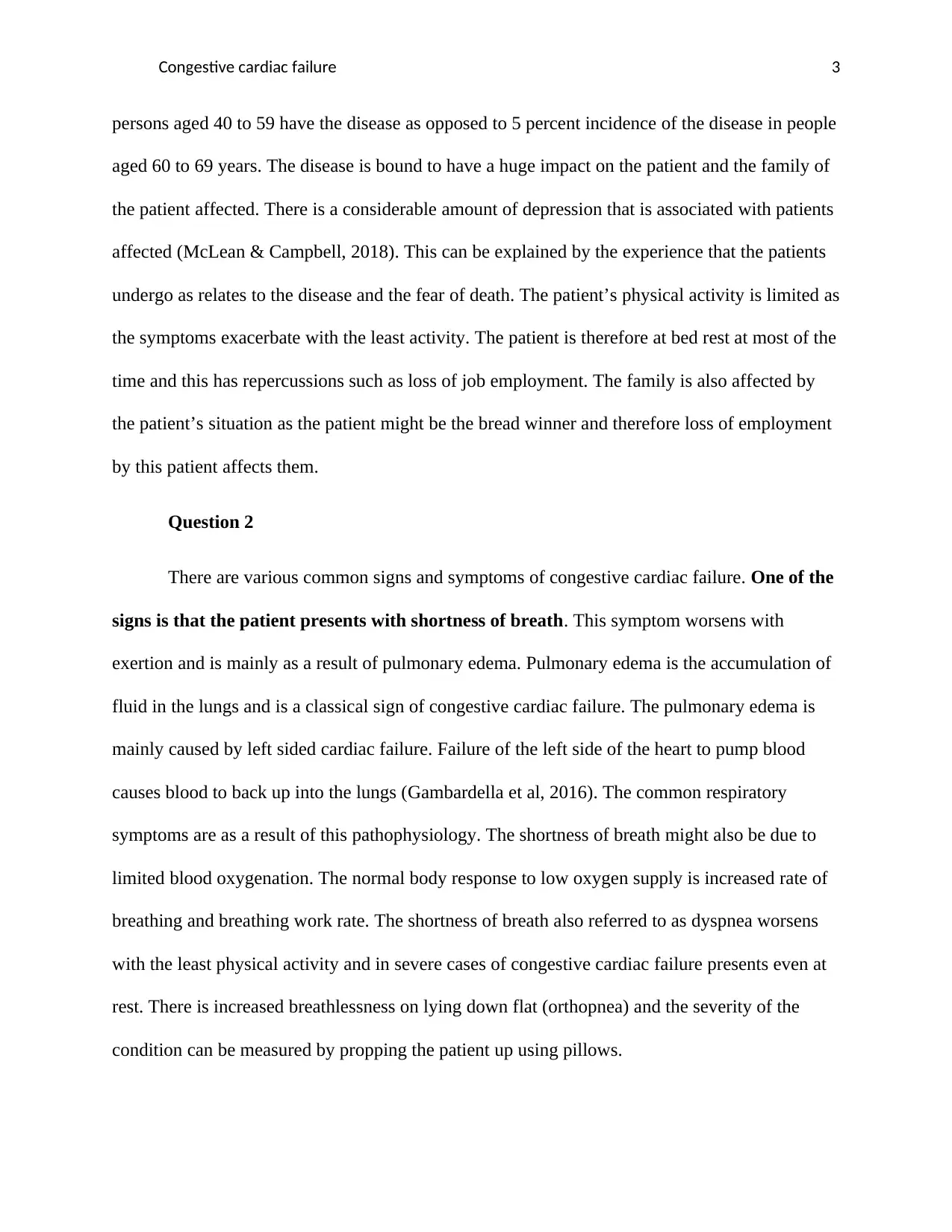
Congestive cardiac failure 3
persons aged 40 to 59 have the disease as opposed to 5 percent incidence of the disease in people
aged 60 to 69 years. The disease is bound to have a huge impact on the patient and the family of
the patient affected. There is a considerable amount of depression that is associated with patients
affected (McLean & Campbell, 2018). This can be explained by the experience that the patients
undergo as relates to the disease and the fear of death. The patient’s physical activity is limited as
the symptoms exacerbate with the least activity. The patient is therefore at bed rest at most of the
time and this has repercussions such as loss of job employment. The family is also affected by
the patient’s situation as the patient might be the bread winner and therefore loss of employment
by this patient affects them.
Question 2
There are various common signs and symptoms of congestive cardiac failure. One of the
signs is that the patient presents with shortness of breath. This symptom worsens with
exertion and is mainly as a result of pulmonary edema. Pulmonary edema is the accumulation of
fluid in the lungs and is a classical sign of congestive cardiac failure. The pulmonary edema is
mainly caused by left sided cardiac failure. Failure of the left side of the heart to pump blood
causes blood to back up into the lungs (Gambardella et al, 2016). The common respiratory
symptoms are as a result of this pathophysiology. The shortness of breath might also be due to
limited blood oxygenation. The normal body response to low oxygen supply is increased rate of
breathing and breathing work rate. The shortness of breath also referred to as dyspnea worsens
with the least physical activity and in severe cases of congestive cardiac failure presents even at
rest. There is increased breathlessness on lying down flat (orthopnea) and the severity of the
condition can be measured by propping the patient up using pillows.
persons aged 40 to 59 have the disease as opposed to 5 percent incidence of the disease in people
aged 60 to 69 years. The disease is bound to have a huge impact on the patient and the family of
the patient affected. There is a considerable amount of depression that is associated with patients
affected (McLean & Campbell, 2018). This can be explained by the experience that the patients
undergo as relates to the disease and the fear of death. The patient’s physical activity is limited as
the symptoms exacerbate with the least activity. The patient is therefore at bed rest at most of the
time and this has repercussions such as loss of job employment. The family is also affected by
the patient’s situation as the patient might be the bread winner and therefore loss of employment
by this patient affects them.
Question 2
There are various common signs and symptoms of congestive cardiac failure. One of the
signs is that the patient presents with shortness of breath. This symptom worsens with
exertion and is mainly as a result of pulmonary edema. Pulmonary edema is the accumulation of
fluid in the lungs and is a classical sign of congestive cardiac failure. The pulmonary edema is
mainly caused by left sided cardiac failure. Failure of the left side of the heart to pump blood
causes blood to back up into the lungs (Gambardella et al, 2016). The common respiratory
symptoms are as a result of this pathophysiology. The shortness of breath might also be due to
limited blood oxygenation. The normal body response to low oxygen supply is increased rate of
breathing and breathing work rate. The shortness of breath also referred to as dyspnea worsens
with the least physical activity and in severe cases of congestive cardiac failure presents even at
rest. There is increased breathlessness on lying down flat (orthopnea) and the severity of the
condition can be measured by propping the patient up using pillows.
⊘ This is a preview!⊘
Do you want full access?
Subscribe today to unlock all pages.

Trusted by 1+ million students worldwide
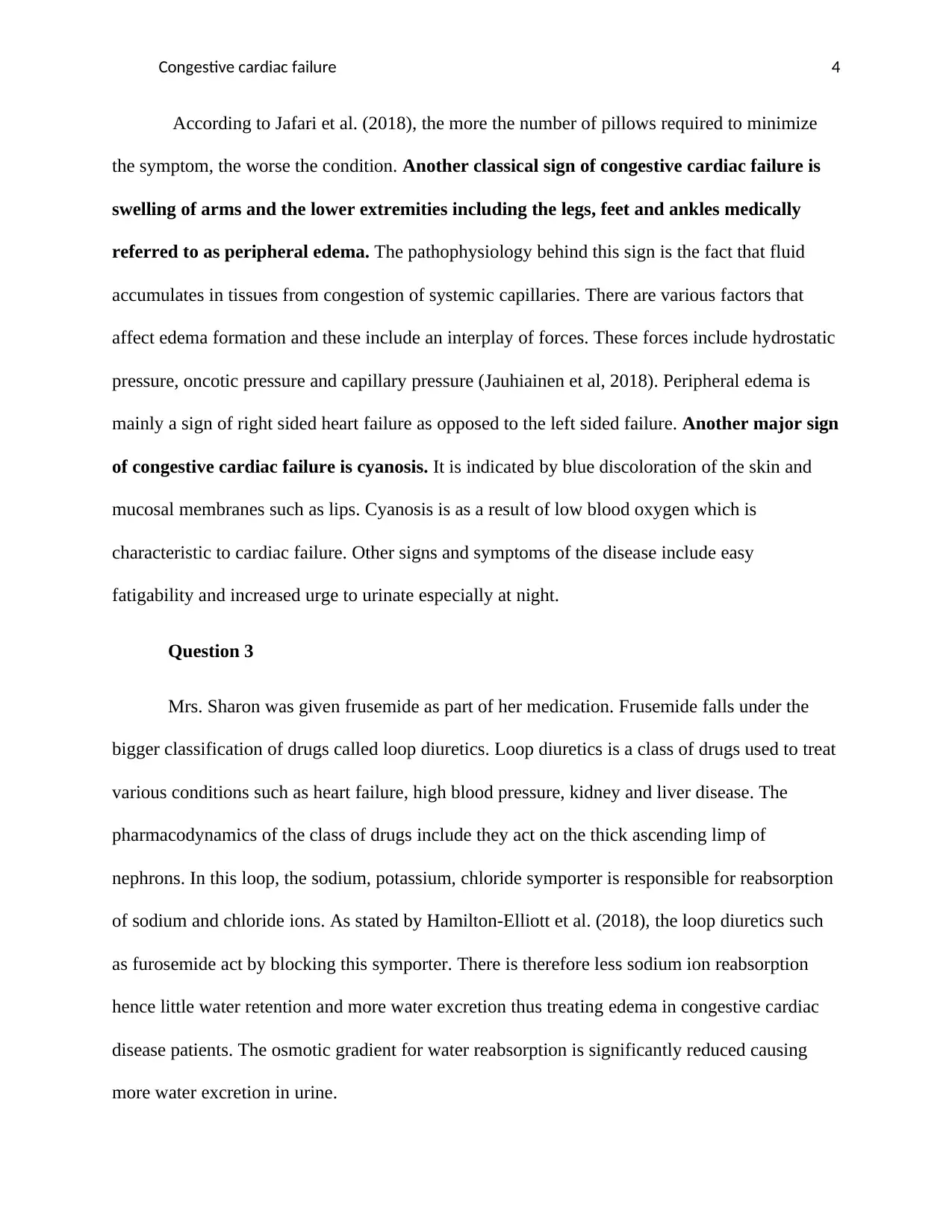
Congestive cardiac failure 4
According to Jafari et al. (2018), the more the number of pillows required to minimize
the symptom, the worse the condition. Another classical sign of congestive cardiac failure is
swelling of arms and the lower extremities including the legs, feet and ankles medically
referred to as peripheral edema. The pathophysiology behind this sign is the fact that fluid
accumulates in tissues from congestion of systemic capillaries. There are various factors that
affect edema formation and these include an interplay of forces. These forces include hydrostatic
pressure, oncotic pressure and capillary pressure (Jauhiainen et al, 2018). Peripheral edema is
mainly a sign of right sided heart failure as opposed to the left sided failure. Another major sign
of congestive cardiac failure is cyanosis. It is indicated by blue discoloration of the skin and
mucosal membranes such as lips. Cyanosis is as a result of low blood oxygen which is
characteristic to cardiac failure. Other signs and symptoms of the disease include easy
fatigability and increased urge to urinate especially at night.
Question 3
Mrs. Sharon was given frusemide as part of her medication. Frusemide falls under the
bigger classification of drugs called loop diuretics. Loop diuretics is a class of drugs used to treat
various conditions such as heart failure, high blood pressure, kidney and liver disease. The
pharmacodynamics of the class of drugs include they act on the thick ascending limp of
nephrons. In this loop, the sodium, potassium, chloride symporter is responsible for reabsorption
of sodium and chloride ions. As stated by Hamilton‐Elliott et al. (2018), the loop diuretics such
as furosemide act by blocking this symporter. There is therefore less sodium ion reabsorption
hence little water retention and more water excretion thus treating edema in congestive cardiac
disease patients. The osmotic gradient for water reabsorption is significantly reduced causing
more water excretion in urine.
According to Jafari et al. (2018), the more the number of pillows required to minimize
the symptom, the worse the condition. Another classical sign of congestive cardiac failure is
swelling of arms and the lower extremities including the legs, feet and ankles medically
referred to as peripheral edema. The pathophysiology behind this sign is the fact that fluid
accumulates in tissues from congestion of systemic capillaries. There are various factors that
affect edema formation and these include an interplay of forces. These forces include hydrostatic
pressure, oncotic pressure and capillary pressure (Jauhiainen et al, 2018). Peripheral edema is
mainly a sign of right sided heart failure as opposed to the left sided failure. Another major sign
of congestive cardiac failure is cyanosis. It is indicated by blue discoloration of the skin and
mucosal membranes such as lips. Cyanosis is as a result of low blood oxygen which is
characteristic to cardiac failure. Other signs and symptoms of the disease include easy
fatigability and increased urge to urinate especially at night.
Question 3
Mrs. Sharon was given frusemide as part of her medication. Frusemide falls under the
bigger classification of drugs called loop diuretics. Loop diuretics is a class of drugs used to treat
various conditions such as heart failure, high blood pressure, kidney and liver disease. The
pharmacodynamics of the class of drugs include they act on the thick ascending limp of
nephrons. In this loop, the sodium, potassium, chloride symporter is responsible for reabsorption
of sodium and chloride ions. As stated by Hamilton‐Elliott et al. (2018), the loop diuretics such
as furosemide act by blocking this symporter. There is therefore less sodium ion reabsorption
hence little water retention and more water excretion thus treating edema in congestive cardiac
disease patients. The osmotic gradient for water reabsorption is significantly reduced causing
more water excretion in urine.
Paraphrase This Document
Need a fresh take? Get an instant paraphrase of this document with our AI Paraphraser
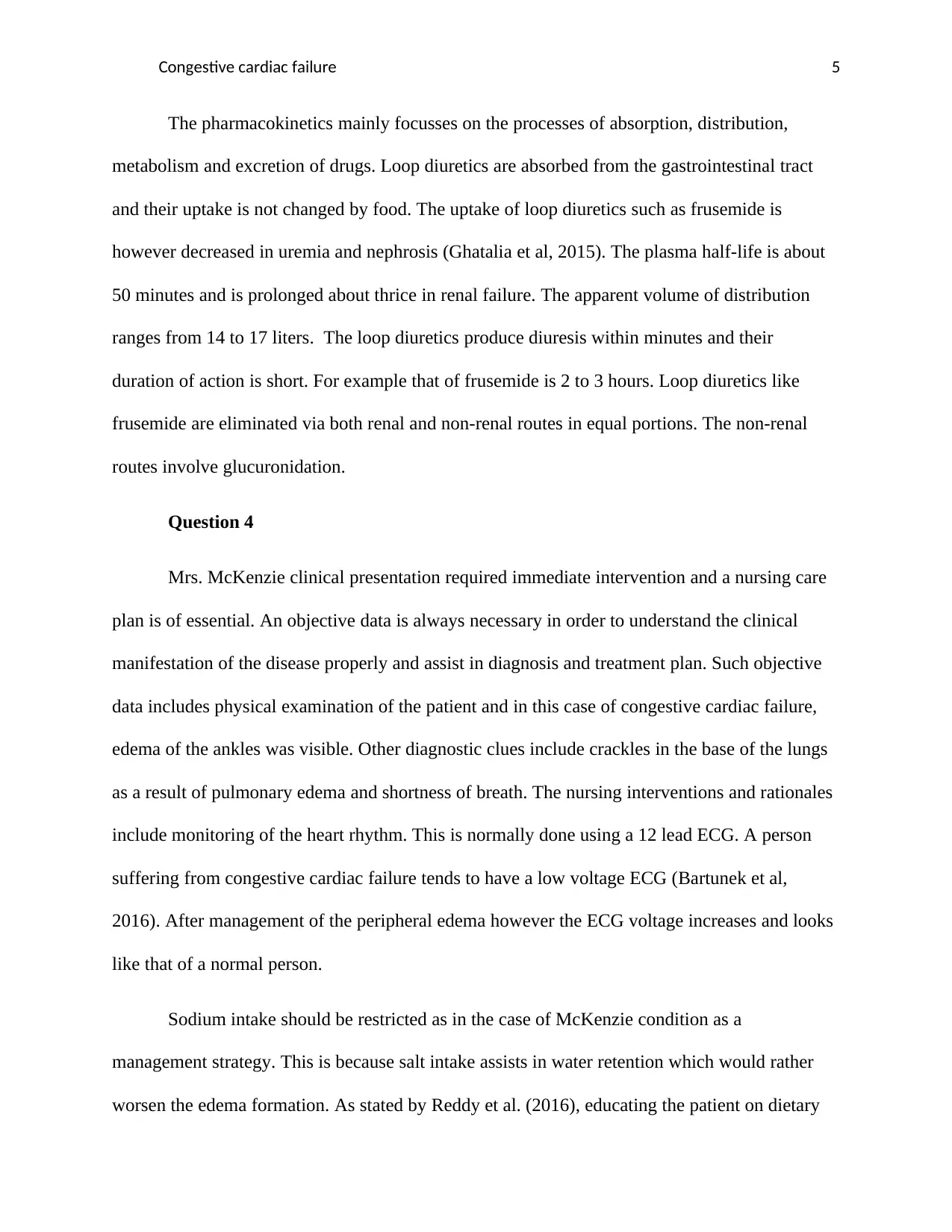
Congestive cardiac failure 5
The pharmacokinetics mainly focusses on the processes of absorption, distribution,
metabolism and excretion of drugs. Loop diuretics are absorbed from the gastrointestinal tract
and their uptake is not changed by food. The uptake of loop diuretics such as frusemide is
however decreased in uremia and nephrosis (Ghatalia et al, 2015). The plasma half-life is about
50 minutes and is prolonged about thrice in renal failure. The apparent volume of distribution
ranges from 14 to 17 liters. The loop diuretics produce diuresis within minutes and their
duration of action is short. For example that of frusemide is 2 to 3 hours. Loop diuretics like
frusemide are eliminated via both renal and non-renal routes in equal portions. The non-renal
routes involve glucuronidation.
Question 4
Mrs. McKenzie clinical presentation required immediate intervention and a nursing care
plan is of essential. An objective data is always necessary in order to understand the clinical
manifestation of the disease properly and assist in diagnosis and treatment plan. Such objective
data includes physical examination of the patient and in this case of congestive cardiac failure,
edema of the ankles was visible. Other diagnostic clues include crackles in the base of the lungs
as a result of pulmonary edema and shortness of breath. The nursing interventions and rationales
include monitoring of the heart rhythm. This is normally done using a 12 lead ECG. A person
suffering from congestive cardiac failure tends to have a low voltage ECG (Bartunek et al,
2016). After management of the peripheral edema however the ECG voltage increases and looks
like that of a normal person.
Sodium intake should be restricted as in the case of McKenzie condition as a
management strategy. This is because salt intake assists in water retention which would rather
worsen the edema formation. As stated by Reddy et al. (2016), educating the patient on dietary
The pharmacokinetics mainly focusses on the processes of absorption, distribution,
metabolism and excretion of drugs. Loop diuretics are absorbed from the gastrointestinal tract
and their uptake is not changed by food. The uptake of loop diuretics such as frusemide is
however decreased in uremia and nephrosis (Ghatalia et al, 2015). The plasma half-life is about
50 minutes and is prolonged about thrice in renal failure. The apparent volume of distribution
ranges from 14 to 17 liters. The loop diuretics produce diuresis within minutes and their
duration of action is short. For example that of frusemide is 2 to 3 hours. Loop diuretics like
frusemide are eliminated via both renal and non-renal routes in equal portions. The non-renal
routes involve glucuronidation.
Question 4
Mrs. McKenzie clinical presentation required immediate intervention and a nursing care
plan is of essential. An objective data is always necessary in order to understand the clinical
manifestation of the disease properly and assist in diagnosis and treatment plan. Such objective
data includes physical examination of the patient and in this case of congestive cardiac failure,
edema of the ankles was visible. Other diagnostic clues include crackles in the base of the lungs
as a result of pulmonary edema and shortness of breath. The nursing interventions and rationales
include monitoring of the heart rhythm. This is normally done using a 12 lead ECG. A person
suffering from congestive cardiac failure tends to have a low voltage ECG (Bartunek et al,
2016). After management of the peripheral edema however the ECG voltage increases and looks
like that of a normal person.
Sodium intake should be restricted as in the case of McKenzie condition as a
management strategy. This is because salt intake assists in water retention which would rather
worsen the edema formation. As stated by Reddy et al. (2016), educating the patient on dietary
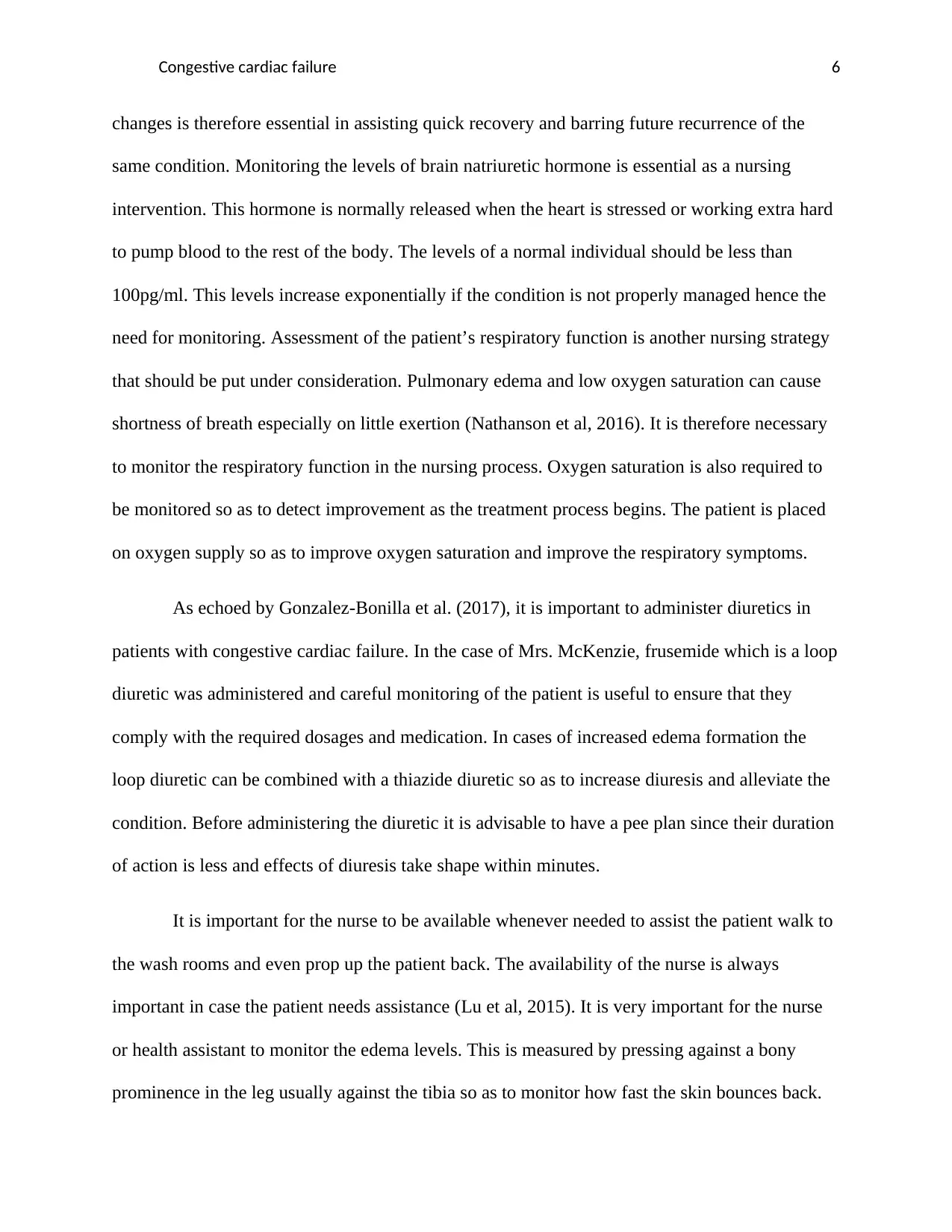
Congestive cardiac failure 6
changes is therefore essential in assisting quick recovery and barring future recurrence of the
same condition. Monitoring the levels of brain natriuretic hormone is essential as a nursing
intervention. This hormone is normally released when the heart is stressed or working extra hard
to pump blood to the rest of the body. The levels of a normal individual should be less than
100pg/ml. This levels increase exponentially if the condition is not properly managed hence the
need for monitoring. Assessment of the patient’s respiratory function is another nursing strategy
that should be put under consideration. Pulmonary edema and low oxygen saturation can cause
shortness of breath especially on little exertion (Nathanson et al, 2016). It is therefore necessary
to monitor the respiratory function in the nursing process. Oxygen saturation is also required to
be monitored so as to detect improvement as the treatment process begins. The patient is placed
on oxygen supply so as to improve oxygen saturation and improve the respiratory symptoms.
As echoed by Gonzalez-Bonilla et al. (2017), it is important to administer diuretics in
patients with congestive cardiac failure. In the case of Mrs. McKenzie, frusemide which is a loop
diuretic was administered and careful monitoring of the patient is useful to ensure that they
comply with the required dosages and medication. In cases of increased edema formation the
loop diuretic can be combined with a thiazide diuretic so as to increase diuresis and alleviate the
condition. Before administering the diuretic it is advisable to have a pee plan since their duration
of action is less and effects of diuresis take shape within minutes.
It is important for the nurse to be available whenever needed to assist the patient walk to
the wash rooms and even prop up the patient back. The availability of the nurse is always
important in case the patient needs assistance (Lu et al, 2015). It is very important for the nurse
or health assistant to monitor the edema levels. This is measured by pressing against a bony
prominence in the leg usually against the tibia so as to monitor how fast the skin bounces back.
changes is therefore essential in assisting quick recovery and barring future recurrence of the
same condition. Monitoring the levels of brain natriuretic hormone is essential as a nursing
intervention. This hormone is normally released when the heart is stressed or working extra hard
to pump blood to the rest of the body. The levels of a normal individual should be less than
100pg/ml. This levels increase exponentially if the condition is not properly managed hence the
need for monitoring. Assessment of the patient’s respiratory function is another nursing strategy
that should be put under consideration. Pulmonary edema and low oxygen saturation can cause
shortness of breath especially on little exertion (Nathanson et al, 2016). It is therefore necessary
to monitor the respiratory function in the nursing process. Oxygen saturation is also required to
be monitored so as to detect improvement as the treatment process begins. The patient is placed
on oxygen supply so as to improve oxygen saturation and improve the respiratory symptoms.
As echoed by Gonzalez-Bonilla et al. (2017), it is important to administer diuretics in
patients with congestive cardiac failure. In the case of Mrs. McKenzie, frusemide which is a loop
diuretic was administered and careful monitoring of the patient is useful to ensure that they
comply with the required dosages and medication. In cases of increased edema formation the
loop diuretic can be combined with a thiazide diuretic so as to increase diuresis and alleviate the
condition. Before administering the diuretic it is advisable to have a pee plan since their duration
of action is less and effects of diuresis take shape within minutes.
It is important for the nurse to be available whenever needed to assist the patient walk to
the wash rooms and even prop up the patient back. The availability of the nurse is always
important in case the patient needs assistance (Lu et al, 2015). It is very important for the nurse
or health assistant to monitor the edema levels. This is measured by pressing against a bony
prominence in the leg usually against the tibia so as to monitor how fast the skin bounces back.
⊘ This is a preview!⊘
Do you want full access?
Subscribe today to unlock all pages.

Trusted by 1+ million students worldwide
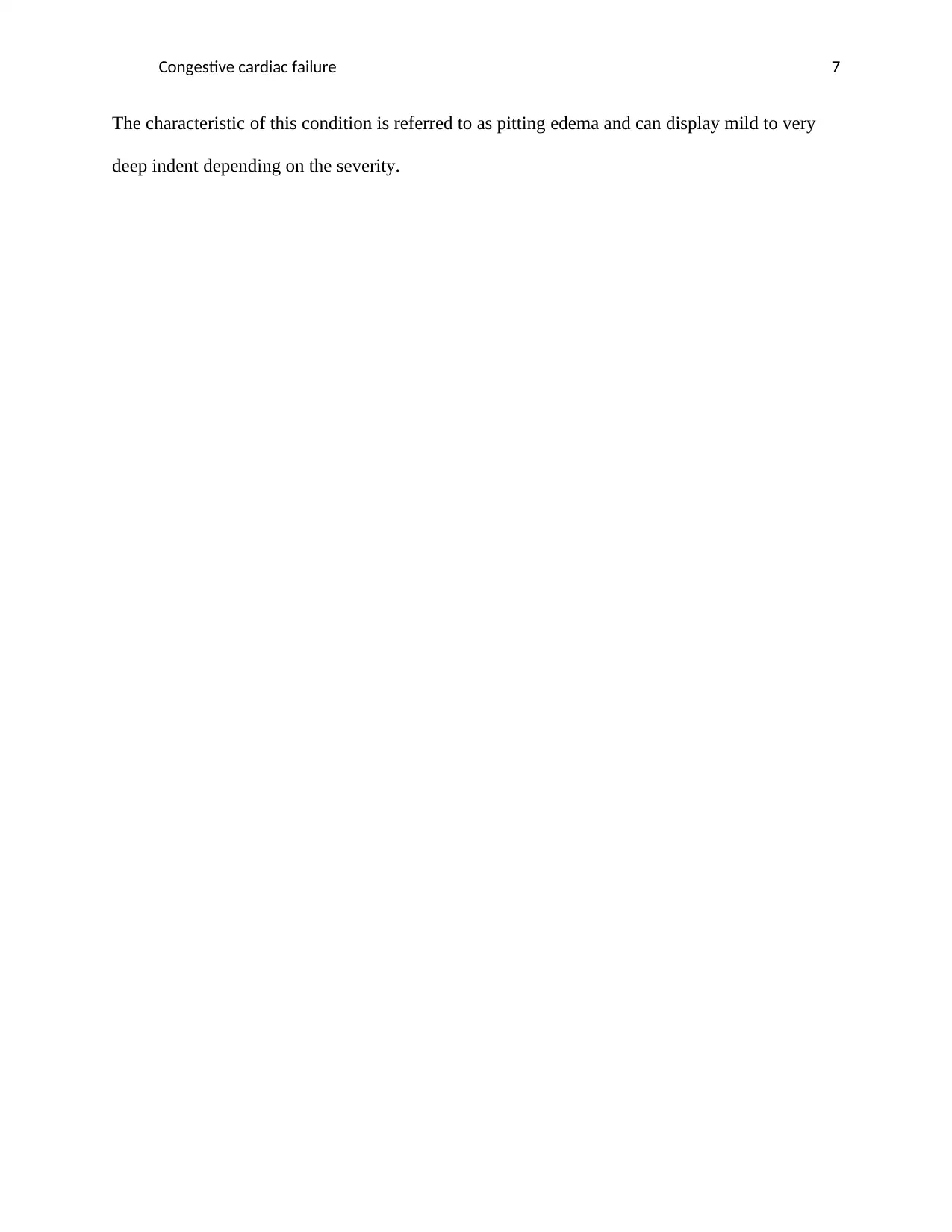
Congestive cardiac failure 7
The characteristic of this condition is referred to as pitting edema and can display mild to very
deep indent depending on the severity.
The characteristic of this condition is referred to as pitting edema and can display mild to very
deep indent depending on the severity.
Paraphrase This Document
Need a fresh take? Get an instant paraphrase of this document with our AI Paraphraser
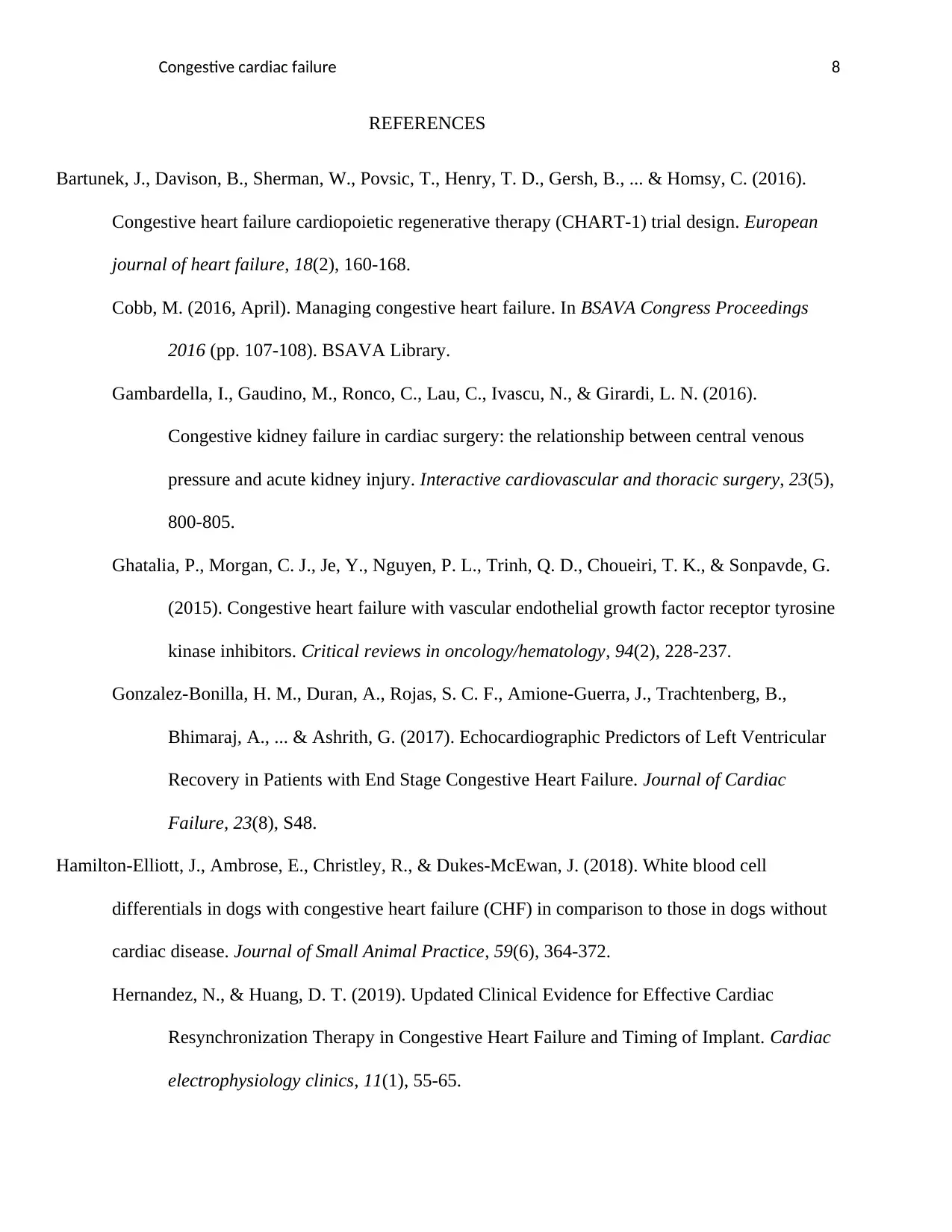
Congestive cardiac failure 8
REFERENCES
Bartunek, J., Davison, B., Sherman, W., Povsic, T., Henry, T. D., Gersh, B., ... & Homsy, C. (2016).
Congestive heart failure cardiopoietic regenerative therapy (CHART‐1) trial design. European
journal of heart failure, 18(2), 160-168.
Cobb, M. (2016, April). Managing congestive heart failure. In BSAVA Congress Proceedings
2016 (pp. 107-108). BSAVA Library.
Gambardella, I., Gaudino, M., Ronco, C., Lau, C., Ivascu, N., & Girardi, L. N. (2016).
Congestive kidney failure in cardiac surgery: the relationship between central venous
pressure and acute kidney injury. Interactive cardiovascular and thoracic surgery, 23(5),
800-805.
Ghatalia, P., Morgan, C. J., Je, Y., Nguyen, P. L., Trinh, Q. D., Choueiri, T. K., & Sonpavde, G.
(2015). Congestive heart failure with vascular endothelial growth factor receptor tyrosine
kinase inhibitors. Critical reviews in oncology/hematology, 94(2), 228-237.
Gonzalez-Bonilla, H. M., Duran, A., Rojas, S. C. F., Amione-Guerra, J., Trachtenberg, B.,
Bhimaraj, A., ... & Ashrith, G. (2017). Echocardiographic Predictors of Left Ventricular
Recovery in Patients with End Stage Congestive Heart Failure. Journal of Cardiac
Failure, 23(8), S48.
Hamilton‐Elliott, J., Ambrose, E., Christley, R., & Dukes‐McEwan, J. (2018). White blood cell
differentials in dogs with congestive heart failure (CHF) in comparison to those in dogs without
cardiac disease. Journal of Small Animal Practice, 59(6), 364-372.
Hernandez, N., & Huang, D. T. (2019). Updated Clinical Evidence for Effective Cardiac
Resynchronization Therapy in Congestive Heart Failure and Timing of Implant. Cardiac
electrophysiology clinics, 11(1), 55-65.
REFERENCES
Bartunek, J., Davison, B., Sherman, W., Povsic, T., Henry, T. D., Gersh, B., ... & Homsy, C. (2016).
Congestive heart failure cardiopoietic regenerative therapy (CHART‐1) trial design. European
journal of heart failure, 18(2), 160-168.
Cobb, M. (2016, April). Managing congestive heart failure. In BSAVA Congress Proceedings
2016 (pp. 107-108). BSAVA Library.
Gambardella, I., Gaudino, M., Ronco, C., Lau, C., Ivascu, N., & Girardi, L. N. (2016).
Congestive kidney failure in cardiac surgery: the relationship between central venous
pressure and acute kidney injury. Interactive cardiovascular and thoracic surgery, 23(5),
800-805.
Ghatalia, P., Morgan, C. J., Je, Y., Nguyen, P. L., Trinh, Q. D., Choueiri, T. K., & Sonpavde, G.
(2015). Congestive heart failure with vascular endothelial growth factor receptor tyrosine
kinase inhibitors. Critical reviews in oncology/hematology, 94(2), 228-237.
Gonzalez-Bonilla, H. M., Duran, A., Rojas, S. C. F., Amione-Guerra, J., Trachtenberg, B.,
Bhimaraj, A., ... & Ashrith, G. (2017). Echocardiographic Predictors of Left Ventricular
Recovery in Patients with End Stage Congestive Heart Failure. Journal of Cardiac
Failure, 23(8), S48.
Hamilton‐Elliott, J., Ambrose, E., Christley, R., & Dukes‐McEwan, J. (2018). White blood cell
differentials in dogs with congestive heart failure (CHF) in comparison to those in dogs without
cardiac disease. Journal of Small Animal Practice, 59(6), 364-372.
Hernandez, N., & Huang, D. T. (2019). Updated Clinical Evidence for Effective Cardiac
Resynchronization Therapy in Congestive Heart Failure and Timing of Implant. Cardiac
electrophysiology clinics, 11(1), 55-65.
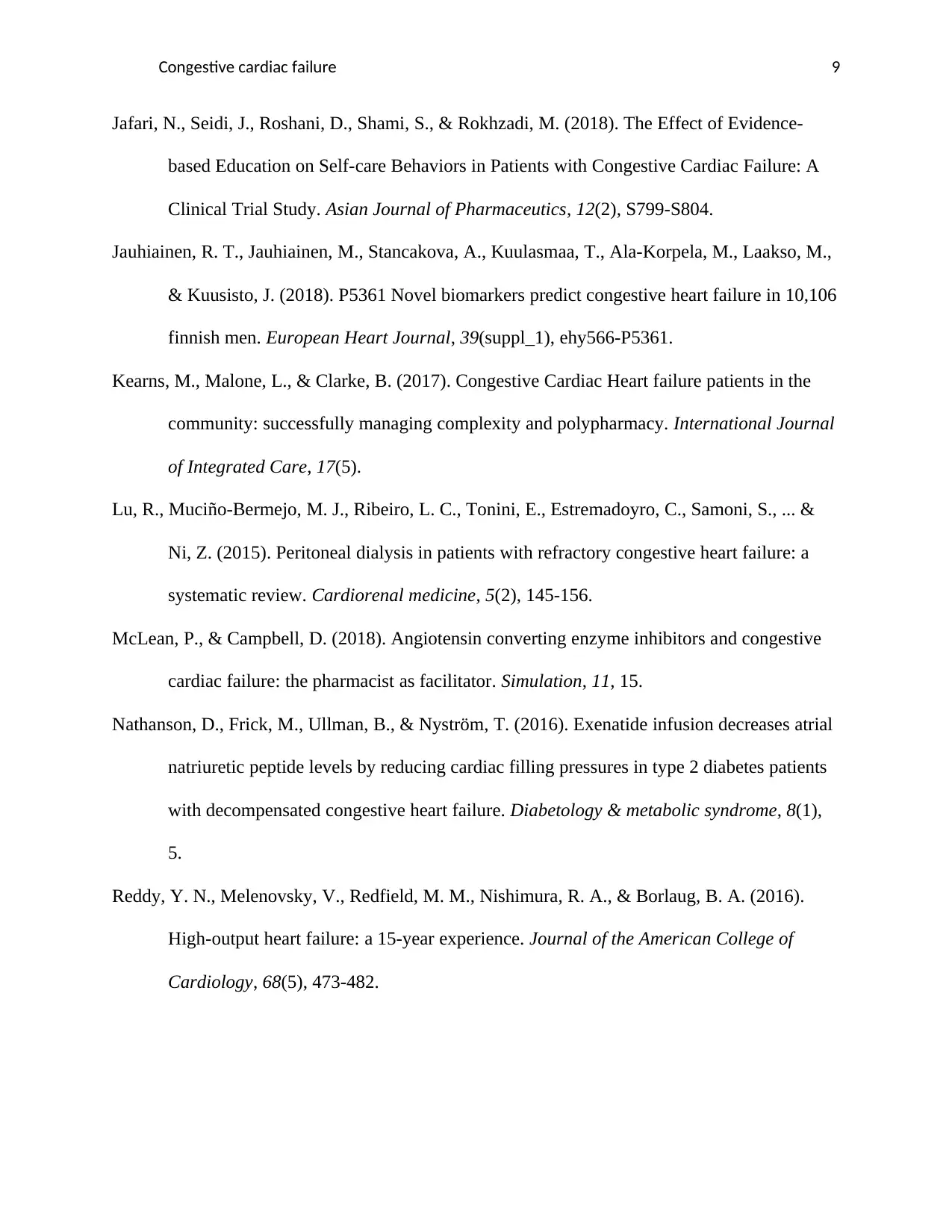
Congestive cardiac failure 9
Jafari, N., Seidi, J., Roshani, D., Shami, S., & Rokhzadi, M. (2018). The Effect of Evidence-
based Education on Self-care Behaviors in Patients with Congestive Cardiac Failure: A
Clinical Trial Study. Asian Journal of Pharmaceutics, 12(2), S799-S804.
Jauhiainen, R. T., Jauhiainen, M., Stancakova, A., Kuulasmaa, T., Ala-Korpela, M., Laakso, M.,
& Kuusisto, J. (2018). P5361 Novel biomarkers predict congestive heart failure in 10,106
finnish men. European Heart Journal, 39(suppl_1), ehy566-P5361.
Kearns, M., Malone, L., & Clarke, B. (2017). Congestive Cardiac Heart failure patients in the
community: successfully managing complexity and polypharmacy. International Journal
of Integrated Care, 17(5).
Lu, R., Muciño-Bermejo, M. J., Ribeiro, L. C., Tonini, E., Estremadoyro, C., Samoni, S., ... &
Ni, Z. (2015). Peritoneal dialysis in patients with refractory congestive heart failure: a
systematic review. Cardiorenal medicine, 5(2), 145-156.
McLean, P., & Campbell, D. (2018). Angiotensin converting enzyme inhibitors and congestive
cardiac failure: the pharmacist as facilitator. Simulation, 11, 15.
Nathanson, D., Frick, M., Ullman, B., & Nyström, T. (2016). Exenatide infusion decreases atrial
natriuretic peptide levels by reducing cardiac filling pressures in type 2 diabetes patients
with decompensated congestive heart failure. Diabetology & metabolic syndrome, 8(1),
5.
Reddy, Y. N., Melenovsky, V., Redfield, M. M., Nishimura, R. A., & Borlaug, B. A. (2016).
High-output heart failure: a 15-year experience. Journal of the American College of
Cardiology, 68(5), 473-482.
Jafari, N., Seidi, J., Roshani, D., Shami, S., & Rokhzadi, M. (2018). The Effect of Evidence-
based Education on Self-care Behaviors in Patients with Congestive Cardiac Failure: A
Clinical Trial Study. Asian Journal of Pharmaceutics, 12(2), S799-S804.
Jauhiainen, R. T., Jauhiainen, M., Stancakova, A., Kuulasmaa, T., Ala-Korpela, M., Laakso, M.,
& Kuusisto, J. (2018). P5361 Novel biomarkers predict congestive heart failure in 10,106
finnish men. European Heart Journal, 39(suppl_1), ehy566-P5361.
Kearns, M., Malone, L., & Clarke, B. (2017). Congestive Cardiac Heart failure patients in the
community: successfully managing complexity and polypharmacy. International Journal
of Integrated Care, 17(5).
Lu, R., Muciño-Bermejo, M. J., Ribeiro, L. C., Tonini, E., Estremadoyro, C., Samoni, S., ... &
Ni, Z. (2015). Peritoneal dialysis in patients with refractory congestive heart failure: a
systematic review. Cardiorenal medicine, 5(2), 145-156.
McLean, P., & Campbell, D. (2018). Angiotensin converting enzyme inhibitors and congestive
cardiac failure: the pharmacist as facilitator. Simulation, 11, 15.
Nathanson, D., Frick, M., Ullman, B., & Nyström, T. (2016). Exenatide infusion decreases atrial
natriuretic peptide levels by reducing cardiac filling pressures in type 2 diabetes patients
with decompensated congestive heart failure. Diabetology & metabolic syndrome, 8(1),
5.
Reddy, Y. N., Melenovsky, V., Redfield, M. M., Nishimura, R. A., & Borlaug, B. A. (2016).
High-output heart failure: a 15-year experience. Journal of the American College of
Cardiology, 68(5), 473-482.
⊘ This is a preview!⊘
Do you want full access?
Subscribe today to unlock all pages.

Trusted by 1+ million students worldwide
1 out of 9
Related Documents
Your All-in-One AI-Powered Toolkit for Academic Success.
+13062052269
info@desklib.com
Available 24*7 on WhatsApp / Email
![[object Object]](/_next/static/media/star-bottom.7253800d.svg)
Unlock your academic potential
Copyright © 2020–2025 A2Z Services. All Rights Reserved. Developed and managed by ZUCOL.




